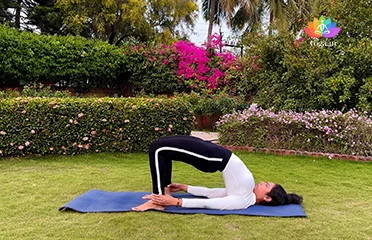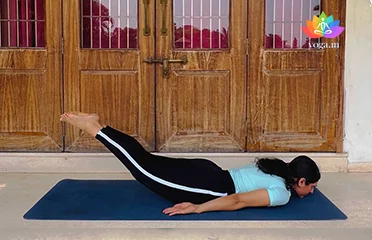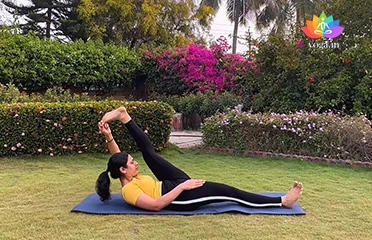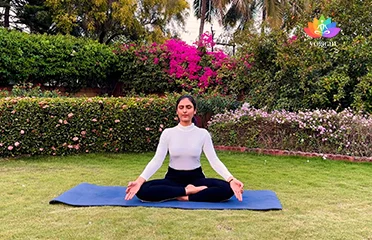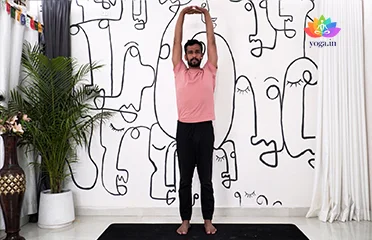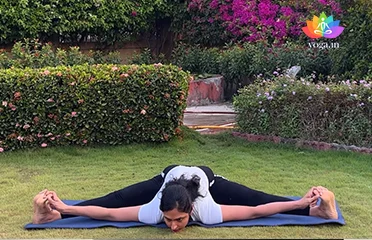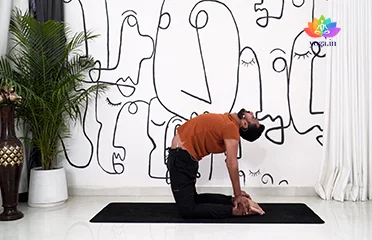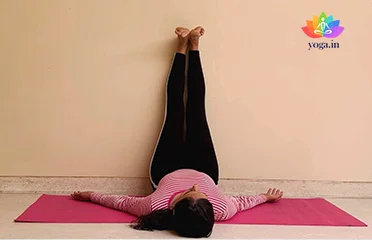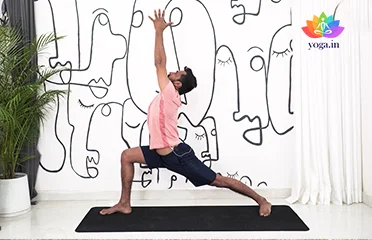Setubandhasana (Bridge Pose)
सेतु बन्धासन / Bridge Pose
The Sanskrit name is derived from Setu (सेतु) meaning bridge, Bandha [�K]
Shalabhasana (Locust Pose)
सलभासन / Locust Pose
The Sanskrit name is derived from Shalabha (शलभा) meaning locust and [�K]
Supta Padangusthasana (Reclining Posture
सुप्त पदंगुष्टासन / Reclining Posture
The Sanskrit name is derived from Supta (सुप्त) meaning 'supine or [�K]
Svastikasana (Auspicious Pose)
स्वस्तिकासन / Auspicious Pose
The Sanskrit name is derived from Swastika (स्वस्तिका) meaning [�K]
Tadasana (Mountain Pose)
ताड़ासन / Mountain Pose
The sanskrit name is derived from tada (ताड़ा) meaning mountain and [�K]
Upavishta Konasana (Wide-Angled Seated F
उपविष्ट कोनासन / Wide-Angled Seated Forward Bend
The Sanskrit name is derived from Upavistha (उपविष्ट) means open/seated, [�K]
Ushtrasana (Camel Pose)
उष्ट्रासनI / Camel Pose
The Sanskrit name is derived from Ushtra (उष्ट्रासनI) meaning [�K]
Viparita Karani (Legs Up The Wall Pose)
विपरिता करणी / Legs Up The Wall Pose
The Sanskrit name is derived from Viparita (विपरिता) meaning inverted [�K]
Virabhadrasana I (Warrior I Pose)
विरभद्रासन I / Warrior I Pose
The Sanskrit name is derived from Vira (विरा) means hero, Bhadra (भद्रा [�K]
- 1
- 2
How Yoga Can Help Cure Hamstring Muscle Issues:
The hamstring muscles, located at the back of the thigh, are crucial for various lower body movements. Tight or strained hamstrings can lead to discomfort and limit mobility. Yoga can effectively aid in treating and relieving hamstring muscle issues by improving flexibility, enhancing blood circulation, and reducing muscle tension through specific stretches and postures.
Understanding Hamstring Muscles:
The hamstring muscles consist of three muscles: the biceps femoris, semitendinosus, and semimembranosus. These muscles work together to facilitate knee bending and hip extension. When these muscles become tight or injured, it can lead to pain, reduced mobility, and difficulty in performing daily activities.
Yoga’s Role in Relieving Hamstring Muscle Issues:
Specific yoga practices can help alleviate hamstring muscle problems by gently stretching and strengthening the muscles, improving flexibility, and promoting relaxation. These include a combination of asanas (postures) that target the hamstrings, pranayama (breathing exercises) to enhance oxygen flow, and relaxation techniques to reduce muscle tension.
Key Factors Contributing to Hamstring Muscle Issues:
Several factors can contribute to hamstring muscle issues, including:
- Lack of Flexibility: Tight hamstrings due to insufficient stretching.
- Overuse: Excessive strain from repetitive activities or sports.
- Inadequate Warm-Up: Insufficient preparation before physical activity.
- Poor Posture: Incorrect posture leading to muscle imbalances.
- Weak Muscles: Lack of strength in the surrounding muscles.
- Inactivity: Sedentary lifestyle causing muscle stiffness.
Symptoms of Hamstring Muscle Issues:
Common symptoms of hamstring muscle issues include:
- Pain in the Thigh: A sharp or dull pain felt at the back of the thigh.
- Stiffness: Reduced flexibility and difficulty in moving the leg.
- Swelling: Inflammation and swelling in the affected area.
- Bruising: Visible bruising if a muscle tear has occurred.
- Weakness: Feeling of weakness in the leg, especially during activities.
- Tenderness: Soreness and tenderness when touching the affected area.
Treatment of Hamstring Muscles through Yoga and Pranayama:
Yoga and pranayama can be highly effective in managing hamstring muscle issues. Some beneficial practices include:
Specific Yoga Poses:
- Paschimottanasana (Seated Forward Bend): Stretches the hamstrings and improves flexibility.
- Uttanasana (Standing Forward Bend): Relieves tension in the hamstrings and lower back.
Pranayama Exercises:
Nadi Shodhana (Alternate Nostril Breathing): Balances energy and reduces stress.
Diet for Hamstring Muscles:
A balanced diet can support the healing of hamstring muscles. Recommendations include:
- Protein-Rich Foods: Lean meats, fish, beans, and legumes for muscle repair.
- Anti-Inflammatory Foods: Berries, turmeric, and green leafy vegetables to reduce inflammation.
- Hydration: Drinking plenty of water to stay hydrated and support muscle function.
- Magnesium-Rich Foods: Nuts, seeds, and whole grains to prevent muscle cramps.
Caution for Hamstring Muscles:
While practicing yoga for hamstring muscle issues, it is essential to:
- Avoid Overstretching: Do not push your body beyond its limits; stretch gently.
- Listen to Your Body: Stop immediately if you feel pain or discomfort.
Consult with a healthcare provider before starting any new exercise regimen, especially if you have a severe hamstring injury.
Contraindications for Hamstring Muscles:
Individuals with severe hamstring injuries or significant pain should:
- Avoid Intense Yoga Practices: Vigorous exercises might exacerbate symptoms.
- Steer Clear of Certain Poses: Deep forward bends and poses that overstretch the hamstrings.
- Seek Professional Guidance: Consult a yoga therapist or healthcare professional for personalized recommendations.


